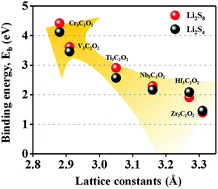Lattice constant-dependent anchoring effect of MXenes for lithium–sulfur (Li–S) batteries: a DFT study†
Abstract
The anchoring effect of the cathode plays a significant role in improving the performance of lithium–sulfur (Li–S) batteries. MXenes, a new class of two-dimensional materials, have been reported to be effective sulfur hosts for Li–S batteries. However, previous studies mainly focused on Ti-based MXenes, while other potential transition metal MXenes have not been systematically explored. In the present work, we thoroughly investigated the interactions between lithium polysulfides (LiPSs) and a Ti2CO2 substrate, as well as six other M3C2O2 (M = Cr, V, Ti, Nb, Hf and Zr) MXenes using density functional theory (DFT) calculations. It is found that all six M3C2O2 systems possess trapping ability towards soluble LiPSs, largely attributed to the strong Li–O interactions between the LiPSs and the surface of the M3C2O2. Among them, Cr3C2O2 exhibited the strongest anchoring effect with the largest Eb. More importantly, a monotonical relationship between the binding energies and the lattice constants of M3C2O2 was identified, which indicated that M3C2O2 MXenes with a smaller lattice constant tend to exhibit a stronger anchoring effect. Furthermore, all six M3C2O2 MXenes showed metallic properties during the whole process. Our results shed light on the future rational selection and design of MXenes acting as sulfur hosts in Li–S batteries and on the potential to improve host–guest interactions in other energy storage systems.



 Please wait while we load your content...
Please wait while we load your content...